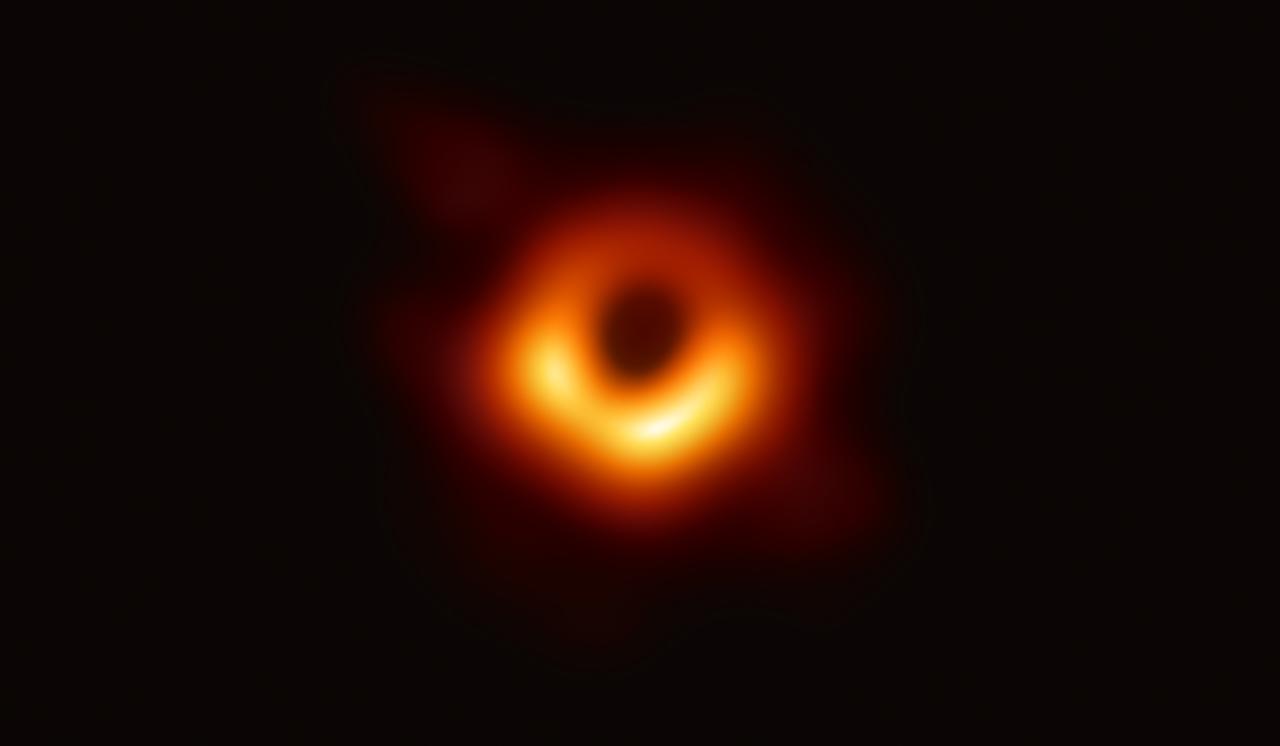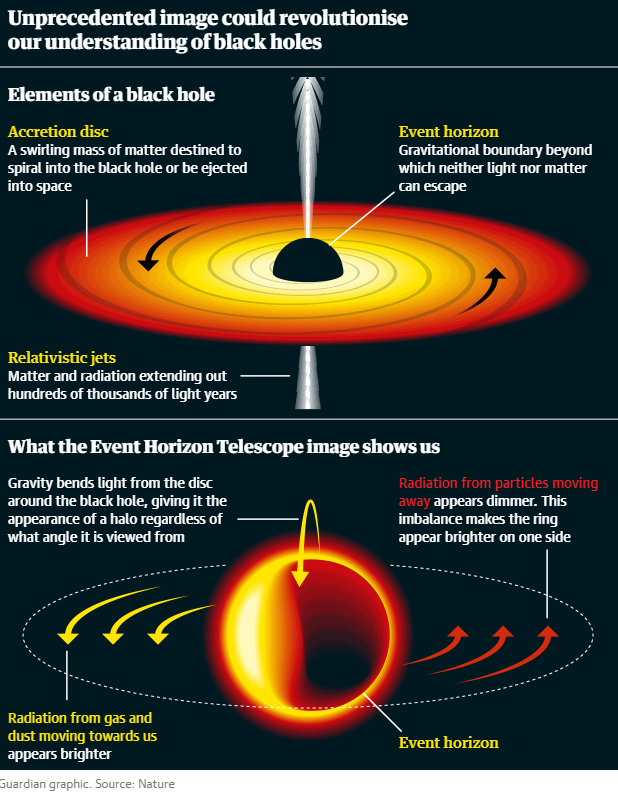Astronomers have captured the first-ever image of a black hole using the Event Horizon Telescope (EHT) – a network of eight radio telescopes spanning the globe at various locations including Antarctica, Spain and Chile – which creates an effective telescope the size of the earth.
The results were presented simultaneously by teams in Tokyo, Washington, Brussels, and Santiago de Chile.
“This major discovery provides visual evidence for the existence of black holes and pushes the boundaries of modern science,” said the European Commission in Brussels in a Wednesday statement.
The image shows a halo of dust and gas steadily “feeding” the black hole’s fuzzy doughnut-shaped accretion disc, according to The Guardian. The colossal black hole is located at the heart of the Messier 87 galaxy in the nearby Virgo galaxy cluster 55-million light-years from Earth.
We are “looking at a region we cannot imagine, the gates of hell, the point of no-return,” said Heino Falcke – Professor of Astroparticle Physics and Radio Astronomy at Radbound University Nijmegen and chair of the EHT Science Council. “To me, it’s awe-inspiring, but it’s also important for physics.”
At the event horizon, light is bent in a perfect loop around the black hole, meaning if you stood there you would be able to see the back of your own head. The observations also provide one of the most stringent tests to date of Einstein’s theory of general relativity: this predicts a rounded shape of the black hole’s halo, in line with what EHT has observed. –The Guardian
Scientists say they observed the source for four days and “the size is always the same, it doesn’t change and we measured the contrast between the ring itself and the central darkness,” Astrophysicist Monika Moscibrodzka from Radboud University Nijmegen said. “This kind of structure can only be formed if something is rotating — could be matter around it or black hole itself. Images give sense of direction of rotation, which is clockwise. We are looking at the shadow of the black hole.” –Bloomberg
“If immersed in a bright region, like a disc of glowing gas, we expect a black hole to create a dark region similar to a shadow — something predicted by Einstein’s general relativity that we’ve never seen before,” said Falcke. “This shadow, caused by the gravitational bending and capture of light by the event horizon, reveals a lot about the nature of these fascinating objects and allowed us to measure the enormous mass of M87’s black hole.”
“Black holes are the most mysterious objects in the universe. We have seen what we thought was unseeable. We have taken a picture of a black hole,” said EHT director and Harvard University senior research fellow, Sheperd Doeleman – who led the project involving more than 200 scientists.
The EHT network detects radiation emitted by particles within the accretion disc that are heated to billions of degrees as they circle the black hole at close to the speed of light – before vanishing.
The halo’s crescent-like appearance in the image is because the particles in the side of the disc rotating towards Earth are flung towards us faster and so appear brighter. The dark shadow within marks the edge of the event horizon, the point of no return, beyond which no light or matter can travel fast enough to escape the inexorable gravitational pull of the black hole.
Black holes were first predicted by Einstein’s theory of relativity – although Einstein himself was sceptical that they actually existed. Since then, astronomers have accumulated overwhelming evidence that these cosmic sinkholes are out there, including recent detection of gravitational waves that ripple across the cosmos when pairs of them collide. –The Guardian
When EHT launched observations in 2017, the program had two primary targets; Sagittarius A – the black hole in the middle of the Milky Way which has a mass of around 4m suns. The second target was the one which yielded the image above – a supermassive black hole into which the equivalent of 6bn suns of light are estimated to have disappeared.
Success meant simultaneous coordination between teams and clear skies on several continents at the same time. Observations were coordinated using atomic clocks known as hydrogen masers – which are accurate to within one second every 100 million years. One night in 2017 – the conditions were perfect.
“We got super lucky, the weather was perfect,” said EHT member Ziri Younsi based at University College London.
According to The Guardian, the observations are already giving scientists insights into how space behaves near a black hole – where gravity is so extreme that reality as we perceive it becomes distorted beyond recognition.
Scientists are also hoping to understand more about the origin of jets of radiation that are blasted out from the poles of some black holes at close to the speed of light, creating brilliant beacons that can be picked out across the cosmos.
However, the observations do not yet reveal anything about the black hole’s inscrutable interior.
“The black hole is not the event horizon, it’s something inside. It could be something just inside the event horizon, an exotic object hovering just beneath the surface, or it could be a singularity at the centre … or a ring,” said Younsi. “It doesn’t yet give us an explanation of what’s going on inside.” –The Guardian
EHT science council chair Heino Falcke said: “The big question for me is whether we’ll ever be able to transcend that limit. The answer may be maybe not. That’s frustrating but we’ll have to accept it.”
via ZeroHedge News http://bit.ly/2UOg8ZT Tyler Durden

